Structures Congress 2019
Sensitivity Analysis on Seismic Performance of Pile-Group Supported Bridges under Combined Effects of Scour and Liquefaction Hazards
Publication: Structures Congress 2019: Bridges, Nonbuilding and Special Structures, and Nonstructural Components
ABSTRACT
Characterizing the effect of varying design parameters on the seismic performance of bridges can assist in optimum seismic design, especially for those in complex geotechnical conditions where scour and liquefaction hazards occur. This paper presents results of sensitivity analyses on the seismic performance of pile-group-supported bridges under combined effects of scour and liquefaction hazards. A fragility-based tornado diagram method is proposed for the sensitivity analyses. The studied parameters include the column height, diameter and axial compressive ratio, pile diameter and center-to-center distance, and relative densities of loose and dense sands. Special attentions are paid to the influence of scour depth on the sensitivity-ranking of the parameters. Main findings are that the pile diameter and center-to-center distance show increasing sensitivity with the increase of scour depth. These two parameters should be treated carefully in the seismic design of scoured bridges in liquefaction ground. On the contrary, relative densities of loose and dense sands that show significant influences for the scenario without scour turn to be the least sensitive parameters for scoured scenarios.
Get full access to this article
View all available purchase options and get full access to this chapter.
Acknowledgment
This work is supported by the National Nature Science Foundation of China (51778469) and the China Postdoctoral Science Foundation. Any opinions, findings, and conclusions expressed are those of the authors, and do not necessarily reflect those of the sponsoring organizations.
REFERENCES
AASHTO. (2012). AASHTO LRFD bridge design specifications. American Association of State Highway and Transportation Officials (AASHTO), Washington, D.C.
Baker, J., Lin, T., Shahi, S., and Jayaram, N. (2011). New ground motion selection procedures and selected motions for the PEER transportation research program. Pacific Earthquake Engineering Research Center, Berkeley, CA.
Bhattacharya, S., Tokimatsu, K., Goda, K., Sarkar, R., Shadlou, M., and Rouholamin, M. (2014). “Collapse of Showa bridge during 1964 Niigata earthquake: A quantitative reappraisal on the failure mechanisms.” Soil Dynamics and Earthquake Engineering, 65, 55–71.
Brandenberg, S. J., Boulanger, R. W., Kutter, B., and Chang, D. (2005). “Behavior of pile foundations in laterally spreading ground during centrifuge tests.” Journal of Geotechnical and Geoenvironmental Engineering, 131(11), 1378–1391.
Brandenberg, S., Kashighandi, P., Zhang, J., Huo, Y., and Zhao, M. (2008). “Sensitivity study of an Older-Vintage Bridge subjected to lateral spreading.” Geotechnical Earthquake Engineering and Soil Dynamics IV, ASCE, Reston, VA.
Brandenberg, S., Kashighandi, P., Zhang, J., Huo, Y., and Zhao, M. (2011). “Fragility functions for bridges in liquefaction-induced lateral spreads.” Earthquake Spectra, 27(3), 683–717.
Cornell, C. A., Jalayer, F., Hamburger, R., and Foutch, D. (2002). “Probabilistic basis for 2000 SAC federal emergency management agency steel moment frame guidelines.” Journal of Structural Engineering, 128(4), 526–533.
Deng, L., Wang, W., and Yu, Y. (2016). “State-of-the-art review on the causes and mechanisms of bridge collapse.” Journal of Performance of Constructed Facilities, 30(2), 04015005.
Jones, A., Kramer, S., and Arduino, P. (2002). Estimation of uncertainty in geotechnical properties for performance-based earthquake engineering. PEER Report, Pacific Earthquake Engineering Research Center, Berkeley, CA.
Klinga, J., and Alipour, A. (2015). “Assessment of structural integrity of bridges under extreme scour conditions.” Engineering Structures, 82, 55–71.
McKenna, F. (2011). “OpenSees: A framework for earthquake engineering simulation.” Computing in Science and Engineering, 13(4), 58–66.
Mokwa, R. (1999). “Investigation of the resistance of pile caps to lateral loading.” Ph.D. dissertation, Virginia Tech, Blacksburg, VA.
Nielson, B., and DesRoches, R. (2007). “Analytical seismic fragility curves for typical bridges in the central and southeastern United States.” Earthquake Spectra, 23(3), 615–633.
Padgett, J., Ghosh, J., and Dueñas-Osorio, L. (2010). “Effects of liquefiable soil and bridge modelling parameters on the seismic reliability of critical structural components.” Structure and Infrastructure Engineering, 9(1), 59–77.
Wang, S., Liu, K., Chen, C., and Chang, K. (2015). “Experimental investigation on seismic behavior of scoured bridge pier with pile foundation.” Earthquake Engineering and Structural Dynamics, 44(6), 849–864.
Wang, X., Ye, A., and Luo, F. (2016a). “Sesimic response sensitivity analysis of pile supported bridge structures in liquefiable ground.” Gongcheng Lixue/Engineering Mechanics. (in Chinese)
Wang, X., Luo, F., Su, Z., and Ye, A. (2017). “Efficient finite-element model for seismic response estimation of piles and soils in liquefied and laterally spreading ground considering shear localization.” International Journal of Geomechanics, 17(6), 06016039.
Wang, X., Shafieezadeh, A., and Ye, A. (2018). “Optimal intensity measures for probabilistic seismic demand modeling of extended pile-shaft-supported bridges in liquefied and laterally spreading ground.” Bulletin of Earthquake Engineering, 16(1), 229–257.
Wang, X., Ye, A., He, Z., and Shang, Y. (2016b). “Quasi-static cyclic testing of elevated RC pile-cap foundation for bridge structures.” Journal of Bridge Engineering, 21(2), 04015042.
Wang, Z., Dueñas-Osorio, L., and Padgett, J. (2014). “Influence of scour effects on the seismic response of reinforced concrete bridges.” Engineering Structures, 76, 202–214.
Zhang, J., and Huo, Y. (2009). “Evaluating effectiveness and optimum design of isolation devices for highway bridges using the fragility function method.” Engineering Structures, 31(8), 1648–1660.
Information & Authors
Information
Published In
Structures Congress 2019: Bridges, Nonbuilding and Special Structures, and Nonstructural Components
Pages: 143 - 153
Editor: James Gregory Soules, McDermott International
ISBN (Online): 978-0-7844-8223-0
Copyright
© 2019 American Society of Civil Engineers.
History
Published online: Apr 22, 2019
Published in print: Apr 22, 2019
Authors
Metrics & Citations
Metrics
Citations
Download citation
If you have the appropriate software installed, you can download article citation data to the citation manager of your choice. Simply select your manager software from the list below and click Download.
